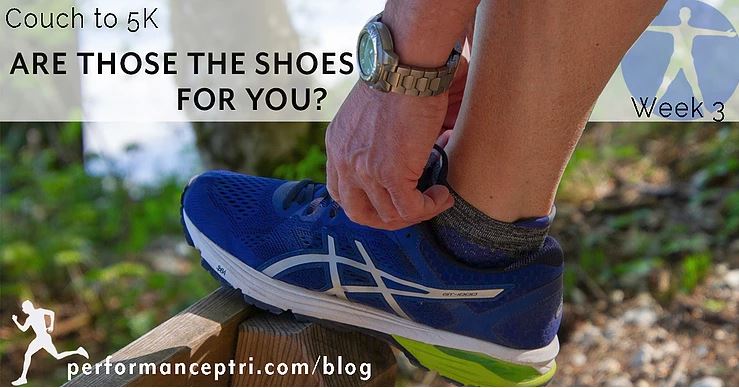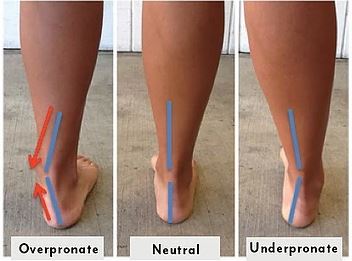
In the 1970’s and 80’s, when an estimated 25 million Americans took up running for the first time, the running shoe industry exploded into being.
Traditional running shoes were then and still are, designed to make your feet and ankles more stable while absorbing the impact of running. But in recent years, minimalist shoes – which include neither cushioning nor stability features – have also become popular with some runners.
So what shoe is right for you?
The types of running shoes
These days, running shoes come in two main types: traditional and minimalist.
In traditional shoes, stability and support may be built into every part of the shoe, from the base of the shoe to the heel design. Stability and motion-control features that are present in some shoes are designed to decrease over and under pronation, which is when the ankle collapses inward or outward as the foot lands. Cushioning is designed to reduce the impact of each step on your feet, knees, and hips. Shoes vary based on the amount of cushion and motion-control features they have, with some shoes having high levels of both, and others, like neutral shoes, having only high cushioning, but no stability features.
The rigid heel counter acts as an internal support feature at the back of the shoe, conforming to the shape of your heel and providing stability to its movement.
The medial post, in motion-control and stability shoes, is at the center of the shoe and provides extra stability and control for overpronators.
The trusstic piece on the bottom of the shoe helps provide the shoe’s strength and improves the runner’s stability by decreasing torsional flexibility.
Minimalist shoes, however, are designed to provide the least stability, support, and cushioning as possible, while still protecting the bottom of your feet from the ground. They’re generally very flexible, light, and lay at or below the ankle.
Why shoes are the way they are
When running shoes were first designed for the masses, there was little evidence that impact or pronation caused injury, so they designed shoes based on what they thought made sense. These days, the research into running shoes and running injuries paints a complicated picture.
Some research has shown that stability features and cushioning of traditional shoes aren’t successful in reducing injury risk and that wearing minimalist shoes can change a runner’s form for the better. Yet there is also evidence that for some populations, traditional shoes can reduce the risk of injury, and for experienced runners, minimalist shoes may increase the risk of injury.
It’s important to note that both of these pieces of evidence could be correct, because many research studies have only looked at specific populations, for too short a period of time, without controlling for other factors like BMI or injury history.
Because of the general lack of good information on minimal footwear, I usually suggest that until more evidence exists, you should avoid minimalist running shoes unless you are a low BMI runner with low weekly mileage (10-15 miles per week at most). If you do end up switching from traditional to minimal running shoes, transition slowly to reduce your risk of injury.
Which shoes are right for you
Note that research on running shoes is ongoing and the recommendations we make now may change. Based on current evidence, the shoe that reduces the risk of injury depends on whether you run neutrally (your ankle doesn’t collapse), underpronate (your ankle collapses out) or overpronate (your ankle collapses in) when you run.

While runners are notoriously bad at identifying how they run, you can try figuring it out by looking at the bottom of any pair of shoes that you wear most often.
If your shoe is worn out more on the full outside edge of the shoe: You may be an underpronator runner (i.e., your ankles collapse outward). Runners whose ankles collapse outward when they run are at an increased risk of stress fractures and should look for a high-cushion shoe. High-cushioned shoes can increase comfort and decrease pressure on the bottom of the foot.
If your shoe is worn out more on the full inside edge of the shoe: You may be an overpronator runner (i.e., your ankles collapse inward). Current research suggests overpronators have a reduced risk of injury in motion-controlled shoes.
If your shoe is worn out equally: You may be a neutral runner (i.e., your ankles don’t collapse outward or inward). Some research has suggested that neutral runners can succeed in any shoe (cushioned, neutral, motion-controlled). Motion-control and high-cushion shoes are heavy, though, so look for neutral, standard-cushion shoes.
If you can’t tell: If you can’t tell from your shoes or want to make sure, you can get your running analyzed. Stores that specialize in selling running shoes often have tools to analyze your feet as you run, and they can suggest shoes that will work for you. You can also get an analysis done at any physical therapy locations that have the technology.
Note: It is normal to have the shoe wear more on the outside edge in the back of the shoe, and on the inside in the front. The above recommendations work only if you see the shoes are worn out on the entire outside or entire inside of the shoe, rather than only in the front or back of the shoe.
Shoes aren’t the only answer to injury-free running
Shoes are an important part of the running picture, but they are not the only part that matters. Keep in mind what shoes can and cannot do for you.
Shoes can:
-Cushion you from high impact forces associated with walking and running.
-Promote proper alignment of the joints of the lower extremity while you are exercising.
-Encourage efficient gait mechanics to minimize your risk of injury while walking or running.
Shoes cannot:
-Address underlying mobility or strength deficits of the lower body and core.
-Cure injuries that you are currently experiencing.
-Replace your stretching and exercise routine.
Local places for running and gait analyses and buying running shoes:
Free gait analysis at shoe store Rhode Runner (located in Providence and Smithfield)
Free gait analysis with a shoe at the sports store, Marathon Sports (located in Mansfield, near our Attleboro location)
Full Running Analysis with Performance Physical Therapy. The Performance Running Analysis is designed to help you run more efficiently, decrease injury, and increase your speed and distance by analyzing your gait, form, strength, and deficiencies. Whether you’re an avid runner looking to increase your speed, a recreational one trying to improve your form and endurance, or you’re looking to recover from a running injury, the Performance Running Analysis is for you. The assessment can be scheduled by calling the Performance Physical Therapy main line at 401.726.7100.